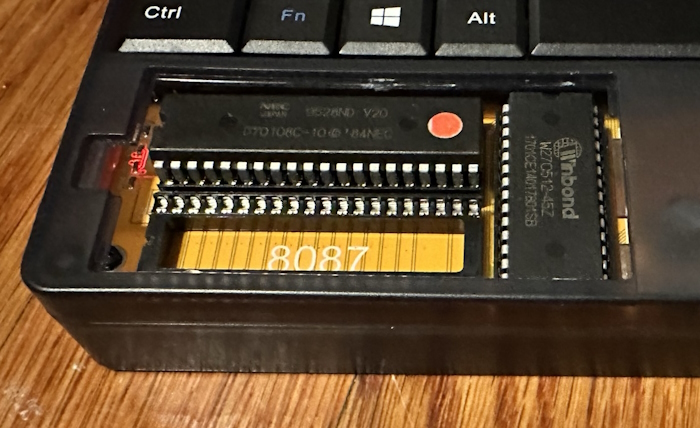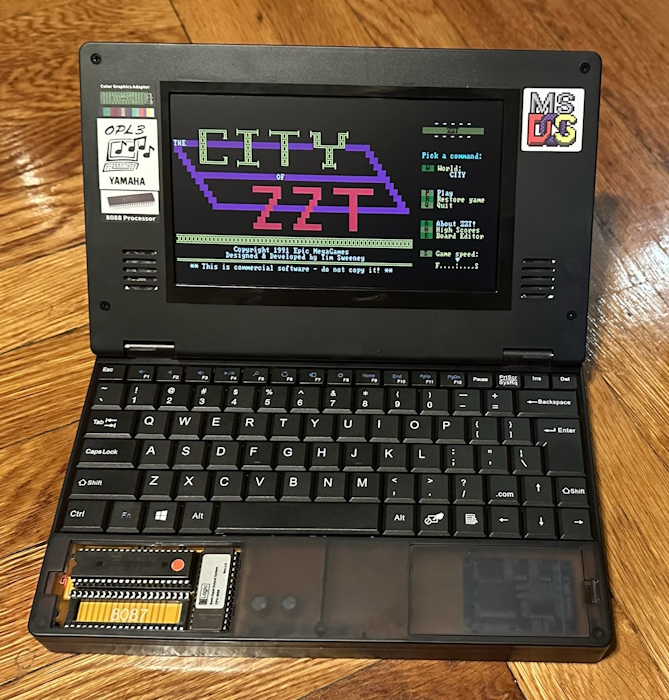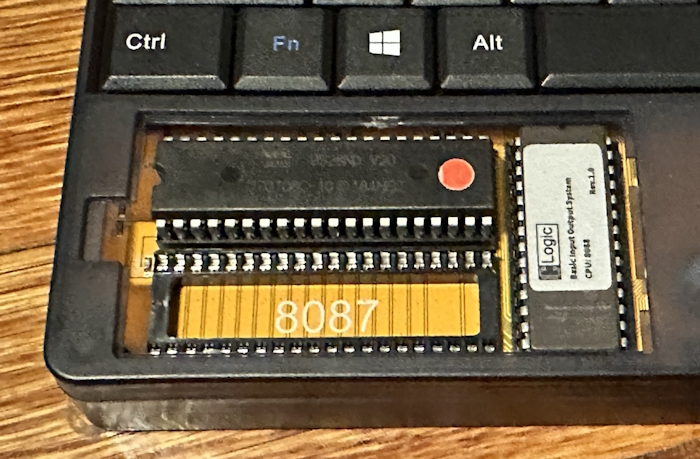Replacing the BIOS on the Book 8088
Imagine: a CGA laptop, in a modern form factor, but with a classic Intel 8088 (or even a NEC V20) inside. Throw in expansions for an ISA bus and an OPL3 sound card, and you’ve got a vintage computer afficionado’s dream, right? Well, for one thing: they stole the BIOS. Let’s fix that.
The Book 8088, bought from an AliExpress seller, is really a cool piece of kit. I don’t actually know much about the origins of this machine, but I have to assume this comes from a Chinese 8088 enthusiast community, rather than just being a tool for interfacing with outdated industrial equipment. Why else would it come with games on board? (Note that I had to install ZZT myself, though)
Also, the CPU is exposed to the world, to say, this isn’t just running DOSBox, this is a real underpowered system. It’s even an NEC V20; apparently most people who buy these find a V20 inside, I wonder if they’re easier to get ahold of than the Genuine Intel(tm). The FPU socket is left open; you can install one if you want, but the developers warn that it’s a battery hog, and I wasn’t planning on doing my taxes on this thing anyway.
So it’s a real bummer that the third chip socket there, the BIOS, is a stolen product. Specifically, it takes most of its code from Sergei Kiselev’s 8088_bios project, which should be only used subject to the GPL 3.0 license.
I suppose from a legal standpoint this isn’t any more egregious than the presence of MS-DOS; after all, Microsoft probably isn’t licensing that anymore. They have open-sourced version 2.0 under the permissive MIT license, but this thing came with MS-DOS 6.22! (Kind of wish they had used MS-DOS 5, so I could link to the obligatory MS-DOS 5 commercial, but it looks like I found an excuse to do that anyway)
Well, from a legal standpoint they might both be copyright violations (I’m no lawyer, though), but when the GPL license is so easy to follow, copying an active open-source project feels a lot worse than copying an obsolete operating system or other software that isn’t even available for license from its developer if they wanted to.
Thankfully, Sergei Kiselev seems to be taking this in stride, releasing a new version of his BIOS tailored for the Book 8088 at the above GitHub link. It even comes in a V20 optimized form; the V20 is not fully compatible with the Intel 80286, since it has no protected mode, but it does support some of the new instructions Intel added, in addition to being ~12% faster in my Tandy 1000HX tests.

A nice thing is that this uses the same 64kiB 27C512 pinout that my SG-1000 cartridges use, so I had a bunch of Winbond chips that were already compatible, and I knew also worked fine in my rapidly-decaying TL866 programmer. A less nice thing is that despite the nice compartment to show it off, I had to unscrew the entire case to get enough space to get the IC actually removed.
Still, I did it, and then I wrote this post to encourage anyone else with the Book 8088 to do so. If for nothing else, the Kiselev BIOS replaces the three beeps that always sounds like an error key to my ears with a PC speaker rendition of the famous Intel chime. I wanted to take a recording, but in true vintage PC fashion, the PC speaker isn’t output over the audio jack… now that’s authenticity, baby.


